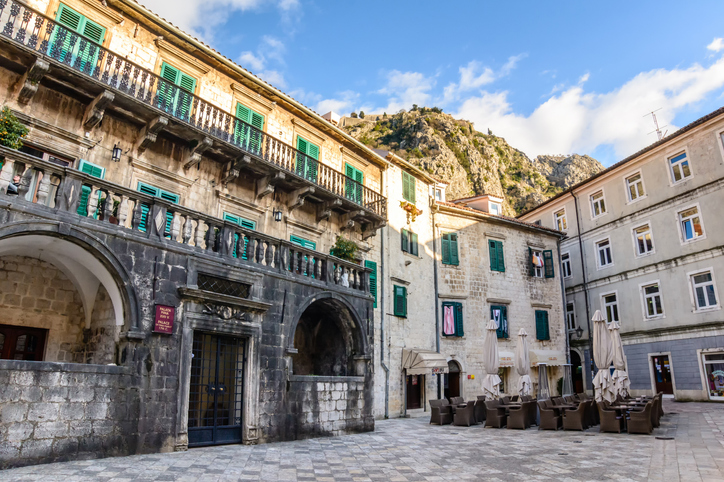 CRUISE GENIE
Downloadfor free now!
CRUISE GENIE
Downloadfor free now!

Kotor Cruise Port sits along Kotor Bay in the Adriatic Sea surrounded by beautiful mountains that make up the Gulf of Kotor region. The port features two terminals and can accommodate multiple large cruise ships at once. It sits conveniently near Old Town Kotor allowing easy walking access to main sights right from the port in about 10 minutes along pretty views.
Taxis, private drivers, and rental cars are available right at the cruise terminal gates offering rides to farther-flung attractions around Kotor, Budva, Perast, or Lovćen National Park high above the city. Travelers can also take local buses leaving near the port entrance making loops to main area destinations very affordable. Many cruise visitors simply walk into charming Kotor Old Town and surrounding areas which provide ample sights packed densely around the port.
Yes, it is just a quick 10-minute walk along the waterside promenade from the cruise port terminal directly to the Sea Gate entrance of historic Kotor Old Town. Follow the waterline path around to easily access this pedestrian-only medieval center showcasing beautiful church architecture and museums as well as restaurants and shops without traffic. From there you can climb the fortified wall overhead for panoramic views over the whole city and bay.
Right outside the port, you can spot Our Lady of the Rocks island housing a historic church, a small marina area, and Pima Palace which was the region’s historical royal residence in centuries past. It is an easy boat ride over. The walk into town passes maritime museum exhibits plus you can see the famous San Giovanni fortress guarding the city clustered on the mountain slopes just behind red rooftops as you look inland.

Kotor Cathedral sits in the heart of the old town next to the Maritime Museum as its biggest highlight holding impressive collections of gold, silver, and art inside making it the city’s most visited landmark today with elements dating back to 1166 AD. Don’t miss it!

This intriguing museum documents the extensive 1000-year-long maritime history the Bay of Kotor region holds including old maps, ship models, paintings, weaponry, and artifacts discovered from shipwrecks in the bay showcasing the long sailing legacy here.

These fortified walls and bastions cling dramatically to rocky mountain slopes looming over Kotor providing panoramic views. They took 200 years to complete offering insights into complex medieval architectural feats through a labyrinth of spaces, towers, and tunnels.

Sitting on a tiny island near the port reachable by boat, this historic royal residence built in 1694 provides a glimpse into the lavish lifestyles of aristocracy from the era through preserved elegant rooms full of art plus sprawling gardens outside to explore the small island grounds it commands.
This petite theater built in the early 19th century performs concerts, folk shows, and plays in an intimate setting characteristic of when it held events for the royal court long ago before modern stages had such effects. It keeps cultural traditions alive in the Old Town.
Kotor Cruise Port is nestled in the stunning Bay of Kotor, Montenegro, offering picturesque views upon arrival.
Several cruise lines, including Norwegian Cruise Line, MSC Cruises, and Royal Caribbean, make regular stops at this port.
The port is conveniently situated near the center of Kotor, just a short walk from the town's main attractions, making it easily accessible for visitors to explore the charming historic center and its cultural treasures within a few minutes walk.
Lorem ipsum dolor sit amet, consectetur adipiscing elit. Zenonis est, inquam, hoc Stoici. Duo Reges: constructio interrete. Quasi ego id curem, quid ille aiat aut neget. Equidem, sed audistine modo de Carneade? Quae tamen a te agetur non melior, quam illae sunt, quas interdum optines. Est igitur officium eius generis, quod nec in bonis ponatur nec in contrariis.
Quid est igitur, cur ita semper deum appellet Epicurus beatum et aeternum? Conferam tecum, quam cuique verso rem subicias; Earum etiam rerum, quas terra gignit, educatio quaedam et perfectio est non dissimilis animantium. Nam quibus rebus efficiuntur voluptates, eae non sunt in potestate sapientis. Hanc ergo intuens debet institutum illud quasi signum absolvere. Summus dolor plures dies manere non potest?
Scientiam pollicentur, quam non erat mirum sapientiae cupido patria esse cariorem. An est aliquid, quod te sua sponte delectet? Non igitur de improbo, sed de callido improbo quaerimus, qualis Q. Mihi enim satis est, ipsis non satis. Hoc sic expositum dissimile est superiori. Eademne, quae restincta siti? Tu vero, inquam, ducas licet, si sequetur; Videsne quam sit magna dissensio?
Cum autem venissemus in Academiae non sine causa nobilitata spatia, solitudo erat ea, quam volueramus.
Lorem ipsum dolor sit amet, consectetur adipiscing elit. Zenonis est, inquam, hoc Stoici. Duo Reges: constructio interrete. Quasi ego id curem, quid ille aiat aut neget. Equidem, sed audistine modo de Carneade? Quae tamen a te agetur non melior, quam illae sunt, quas interdum optines. Est igitur officium eius generis, quod nec in bonis ponatur nec in contrariis.
Quid est igitur, cur ita semper deum appellet Epicurus beatum et aeternum? Conferam tecum, quam cuique verso rem subicias; Earum etiam rerum, quas terra gignit, educatio quaedam et perfectio est non dissimilis animantium. Nam quibus rebus efficiuntur voluptates, eae non sunt in potestate sapientis. Hanc ergo intuens debet institutum illud quasi signum absolvere. Summus dolor plures dies manere non potest?
Scientiam pollicentur, quam non erat mirum sapientiae cupido patria esse cariorem. An est aliquid, quod te sua sponte delectet? Non igitur de improbo, sed de callido improbo quaerimus, qualis Q. Mihi enim satis est, ipsis non satis. Hoc sic expositum dissimile est superiori. Eademne, quae restincta siti? Tu vero, inquam, ducas licet, si sequetur; Videsne quam sit magna dissensio?
Cum autem venissemus in Academiae non sine causa nobilitata spatia, solitudo erat ea, quam volueramus.